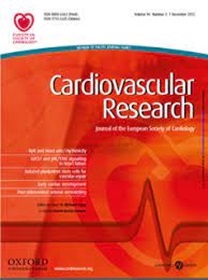多余小叶原基重塑导致原纤毛缺失导致双尖瓣主动脉瓣(BAV)
IF 13.3
1区 医学
Q1 CARDIAC & CARDIOVASCULAR SYSTEMS
引用次数: 0
摘要
目的:双尖瓣主动脉瓣(BAV),其中发现两个瓣叶而不是通常的三个瓣叶,影响1-2%的普通人群,并与显著的发病率和死亡率相关。尽管发病率很高,但大多数病例仍无法解释。这至少部分是因为有两种类型的瓣膜小叶原基:心内膜垫和嵌入瓣膜肿胀(ICVS)。此外,多个祖细胞对这些原基的形成有不同的贡献。小鼠和人类的基因组研究表明,BAV与初级纤毛功能障碍之间存在相关性。然而,在早期胚胎瓣膜形成过程中纤毛的确切需求仍不清楚。方法和结果在这里,我们使用特定的Cre驱动程序,通过删除形成主动脉瓣的主要祖细胞中的纤毛基因Ift88来破坏原代纤毛:Wnt1-Cre用于神经嵴细胞,Isl1-Cre用于第二心野细胞(SHF);Tie2-Cre用于心内膜源性细胞,Tnnt2-Cre用于ICVS中直接分化SHF。神经嵴细胞和心内膜中Ift88的缺失以及初级纤毛的缺失并不影响主动脉瓣的形成。然而,初级纤毛在主动脉瓣小叶形成的SHF细胞中是必不可少的,超过一半的Ift88f/f;Isl1-Cre突变体表现为BAV。当瓣膜小叶形成时,50%的Ift88f/f;Isl1-Cre突变体在通常的后小叶的位置上有两个小的小叶,这意味着在这个阶段主动脉瓣是四尖瓣,然后在E15.5重塑为BAV。机制研究表明,SHF细胞早分化为ICVS形式,导致形成一个增宽的ICVS,形成两个后小叶前体。ICVS形成中的这种异常与Notch-Jag1信号通路的破坏有关,Jag1f/f;Isl1-Cre突变体呈现类似的表型。结论原发性纤毛通过Notch-Jag1信号通路调控主动脉瓣原基SHF细胞的分化。此外,我们确定了四尖瓣和二尖瓣动脉瓣小叶发育基础之间的机制联系。本文章由计算机程序翻译,如有差异,请以英文原文为准。
Remodelling of supernumerary leaflet primordia leads to bicuspid aortic valve (BAV) caused by loss of primary cilia
Aims Bicuspid aortic valve (BAV), where two valve leaflets are found instead of the usual three, affects 1-2% of the general population and is associated with significant morbidity and mortality. Despite its frequency, the majority of cases remain unexplained. This is, at least in part, because there are two types of valve leaflet primordia: endocardial cushions and intercalated valve swellings (ICVS). Moreover, multiple progenitors make distinct contribution to the formation of these primordia. Genomic studies in mouse and human have suggested a correlation between BAV and malfunctional primary cilia. However, the precise requirement for cilia during early embryonic valvulogenesis remains unknown. Methods and results Here, we disrupted primary cilia by deleting the ciliary gene Ift88 in the main progenitor cells forming the aortic valve using specific Cre drivers: Wnt1-Cre for neural crest cells, Isl1-Cre for second heart field cells (SHF); Tie2-Cre for endocardial-derived cells and Tnnt2-Cre for direct-differentiating SHF in the ICVS. Loss of Ift88, and thus primary cilia, from neural crest cells and endocardium did not impact aortic valve formation. However, primary cilia are essential in SHF cells for aortic valve leaflet formation, with over half of Ift88f/f;Isl1-Cre mutants presenting with BAV. As the valve leaflets are forming, 50% of the Ift88f/f;Isl1-Cre mutants have two small leaflets in the position of the usual posterior leaflet, meaning that at this stage the aortic valve is quadricuspid, which then remodels to BAV by E15.5. Mechanistic studies demonstrate premature differentiation of SHF cells as the ICVS form, leading to the formation of a broadened ICVS that forms two posterior leaflet precursors. This abnormality in the formation of the ICVS is associated with disruption of Notch-Jag1 signalling pathway, with Jag1f/f;Isl1-Cre mutants presenting with a similar phenotype. Conclusions These data show that primary cilia, via the Notch-Jag1 signalling pathway, regulate differentiation of SHF cells in the aortic valve primordia. Additionally, we identify a mechanistic link between the developmental basis of quadricuspid and bicuspid arterial valve leaflets.
求助全文
通过发布文献求助,成功后即可免费获取论文全文。
去求助
来源期刊

Cardiovascular Research
医学-心血管系统
CiteScore
21.50
自引率
3.70%
发文量
547
审稿时长
1 months
期刊介绍:
Cardiovascular Research
Journal Overview:
International journal of the European Society of Cardiology
Focuses on basic and translational research in cardiology and cardiovascular biology
Aims to enhance insight into cardiovascular disease mechanisms and innovation prospects
Submission Criteria:
Welcomes papers covering molecular, sub-cellular, cellular, organ, and organism levels
Accepts clinical proof-of-concept and translational studies
Manuscripts expected to provide significant contribution to cardiovascular biology and diseases
 求助内容:
求助内容: 应助结果提醒方式:
应助结果提醒方式:


